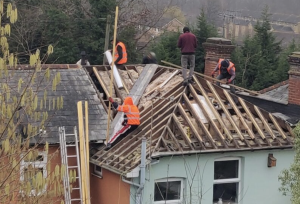Three firms fined after worker broke leg in trench collapse
This post has already been read 3333 times!
Three companies have been sentenced today (19 December 2016) in Lincoln Crown Court after a worker’s leg was broken in six places when a trench which he was working in collapsed on him.
Vincent Talbot, 47, from Lincoln, suffered serious leg injuries when his leg was crushed in the incident at Fleet Street, Holbeach, Lincolnshire on 9 March 2012.
He was trapped in the trench for 15 minutes before being extracted by the fire and rescue service and then airlifted to hospital.
His right ankle has been left permanently damaged, pointing 10 degrees off line. He was off work for more than a year and vows never to work in a trench again.
An investigation by the Health and Safety Executive (HSE) found insufficient measures were taken to protect those working in trench, and a series of safety errors had led to the collapse.
Principal contractor, Kier MG Ltd, was appointed by Lincolnshire County Council to install new storm drains.
Kier MG Ltd sub-contracted the installation work to John Henry & Sons (Civil Engineers) Ltd, who subsequently further sub-contracted the work to Lawless Civils Ltd. Mr Talbot was a self- employed contractor hired by Lawless Civils Ltd. John Henry & Sons (Civil Engineers) Ltd, failed to inform Kier MG of the appointment of Lawless Civils Ltd. Lawless were approved contractors of Kier MG but not approved for this type of specialist excavation work. Lawless appointed a supervisor who had never supervised work, he did not have the relevant training and qualifications to do so.
After the accident to Vince Talbot, John Henry & Sons (Civil Engineers) Ltd, backdated the method statement to give the impression that it was signed by the workers prior to the trench collapsing.
A three-metre long trench box shielded workers but the pipes being laid in the trench were six metres long, meaning workers weren’t protected over the length of the pipe.
Other trench support systems such as trench sheeting were not used, and the unsupported trench had water leaking into it.
The trench had been left open overnight and concrete was being used to bed the pipes in at the bottom of the trench, instead of pea gravel as specified by the client.
Water mixed with the concrete, making the pipe levelling process extremely difficult as the level of the pipe bed had to be continuously adjusted.
When Vince Talbot was attempting to level a pipe section for a second time, the sides of the trench collapsed and trapped him.
Kier MG Ltd (formerly known as May Gurney Ltd) of Tempsford Hall, Sandy, Bedfordshire, pleaded guilty to breaching Regulation 22(1)(a) of the Construction (Design and Management) Regulations 2007. They were fined £1.5million and ordered to pay £23,327.83.
John Henry & Sons (Civil Engineers) Ltd of Barnwell Road, Cambridge denied the charge but was found guilty, after a trial of breaching section 3(1) of the Health and Safety at Work etc. Act 1974. They were fined £550,000 and ordered to pay £166,217.86.
Lawless Civils Ltd of Doddington Road, Lincoln, pleaded guilty to breaching section 3(1) of the Health and Safety at Work etc Act 1974. They were fined £40,500 and ordered to pay £53,346.59.
HSE inspector Martin Waring said: “This incident was foreseeable and avoidable and Mr Talbot’s injuries were the result of multiple failings by the duty holders, from the planning stage through to the execution of the project, resulting in the inevitable collapse of an unsupported trench. Sufficient trench support systems were not provided.
“Even while the excavation phase had begun, a catalogue of errors and omissions led to the injuries of Vincent Talbot. It is inevitable that at some time an unsupported trench will collapse, for this reason safe systems of work, should be in place in order to protect persons who work in trenches. We could easily have been dealing with a fatal incident.”
Further information on planning and safely undertaking excavation work can be found on the HSE website at: http://www.hse.gov.uk/construction/safetytopics/excavations.htm























